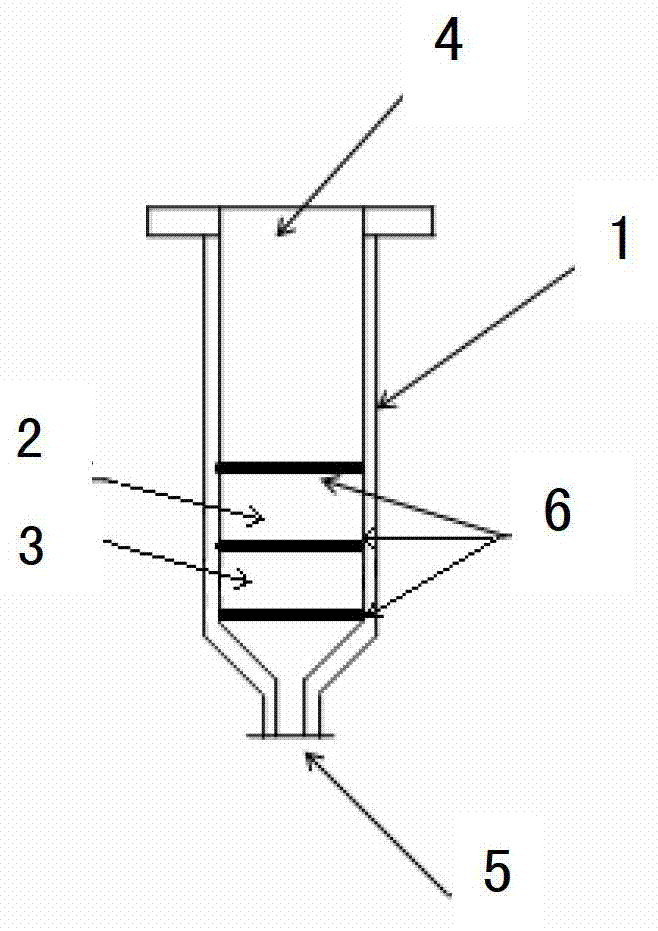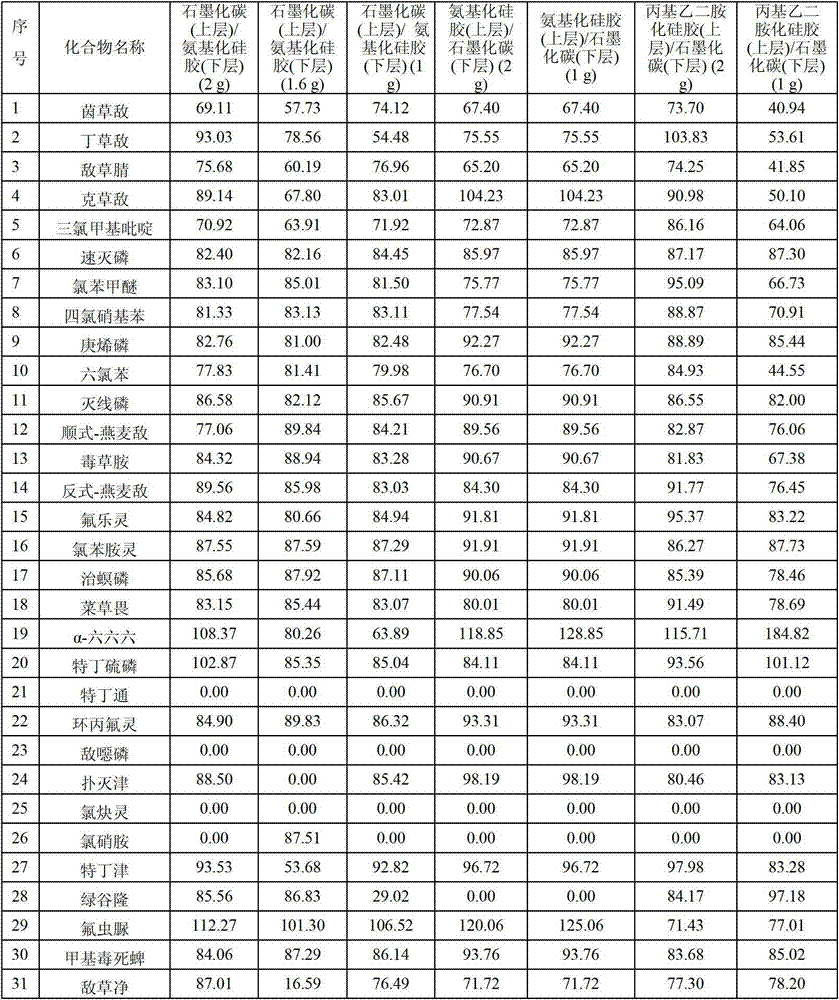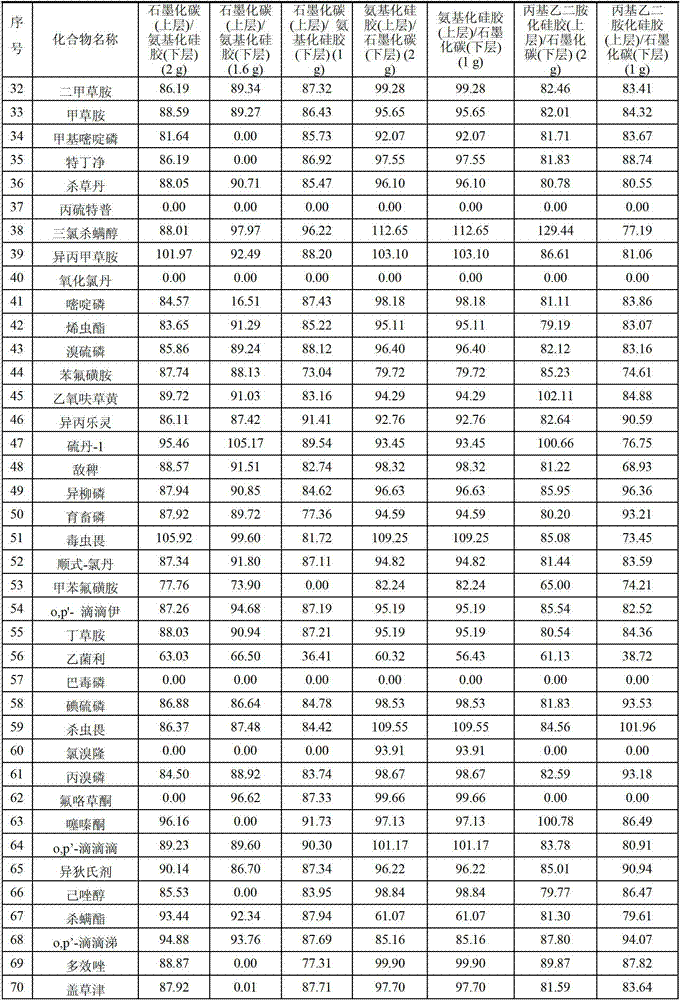Tea solid phase extraction column and sample pretreatment method for testing pesticide residues in tea leaves
A solid-phase extraction column and sample pretreatment technology, applied in separation methods, chemical instruments and methods, measuring devices, etc., can solve the problems that cannot be applied to the extraction and purification of pesticide residues, and achieve good adsorption and removal effects
- Summary
- Abstract
- Description
- Claims
- Application Information
AI Technical Summary
Problems solved by technology
Method used
Image
Examples
Embodiment 1
[0050] Use a high-density polyethylene column tube with a volume capacity of 6mL or 12mL. One end of the column tube 1 is the sample or solvent injection port 4, and the other end is the sample or solvent outflow port 5, which is filled with graphitized carbon, aminated silica gel NH2 , amidated polyethylene divinyl benzene three materials, in which aminated silica gel NH2 and amidated polyethylene divinyl benzene are mixed as a layer 2, graphitized carbon is used as a layer 3, and a polypropylene sieve plate 6 with a pore size of 20um is used as a layer Separation, both ends of the filler are sealed by sieve plates, filled with two layers of three materials mixed purification column, graphitized carbon, aminated silica gel NH2 and amidated polyethylene divinylbenzene three materials in the tea solid phase extraction column The mass ratio is 8:8:1, and the graphitized carbon is packed at the bottom of the column tube.
Embodiment 2
[0052] Use a high-density polyethylene column tube with a volume capacity of 6mL or 12mL. One end of the column tube 1 is the sample or solvent injection port 4, and the other end is the sample or solvent outflow port 5, which is filled with graphitized carbon, aminated silica gel NH2 , amidated polyethylene divinyl benzene three materials, in which aminated silica gel NH2 and amidated polyethylene divinyl benzene are mixed as a layer 2, graphitized carbon is used as a layer 3, and a polypropylene sieve plate 6 with a pore size of 20um is used as a layer Separation, both ends of the filler are sealed by sieve plates, filled with two layers of three materials mixed purification column, graphitized carbon, aminated silica gel NH2 and amidated polyethylene divinylbenzene three materials in the tea solid phase extraction column The mass ratio is 6:4:1, and the graphitized carbon is packed at the bottom of the column tube.
Embodiment 3
[0054] Use a glass column tube with a volume capacity of 6mL or 12mL. One end of the column tube 1 is the sample or solvent injection port 4, and the other end is the sample or solvent outflow port 5, which is filled with graphitized carbon, aminated silica gel NH2, amidated Polyethylene divinyl benzene three materials, in which aminated silica gel NH2 and amidated polyethylene divinyl benzene are mixed as a layer 2, graphitized carbon is used as a layer 3, and a polypropylene sieve plate 6 with a pore size of 20um is used as a separator and filler The two ends of the tea are sealed by sieve plates, filled with a two-layer mixed purification column of three materials, the mass ratio of graphitized carbon, aminated silica gel NH2 and amidated polyethylene divinylbenzene in the tea solid phase extraction column The ratio is 5:4:1, where the graphitized carbon is packed at the bottom of the column tube.
PUM
| Property | Measurement | Unit |
|---|---|---|
| particle size (mesh) | aaaaa | aaaaa |
| specific surface area | aaaaa | aaaaa |
| particle diameter | aaaaa | aaaaa |
Abstract
Description
Claims
Application Information
 Login to View More
Login to View More - R&D
- Intellectual Property
- Life Sciences
- Materials
- Tech Scout
- Unparalleled Data Quality
- Higher Quality Content
- 60% Fewer Hallucinations
Browse by: Latest US Patents, China's latest patents, Technical Efficacy Thesaurus, Application Domain, Technology Topic, Popular Technical Reports.
© 2025 PatSnap. All rights reserved.Legal|Privacy policy|Modern Slavery Act Transparency Statement|Sitemap|About US| Contact US: help@patsnap.com



